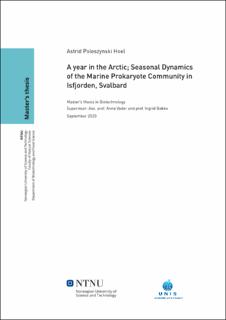| dc.contributor.advisor | Vader, Anna | |
| dc.contributor.advisor | Bakke, Ingrid | |
| dc.contributor.author | Astrid Poleszynski Hoel | |
| dc.date.accessioned | 2021-09-25T16:12:18Z | |
| dc.date.available | 2021-09-25T16:12:18Z | |
| dc.date.issued | 2020 | |
| dc.identifier | no.ntnu:inspera:56743445:5174275 | |
| dc.identifier.uri | https://hdl.handle.net/11250/2782605 | |
| dc.description.abstract | Denne oppgaven representerer en pilot studie angående det marine prokaryotiske samfunnet ved IsA tidsseriestasjonen (78°N, 15°E) i Isfjorden, Svalbard. Vannprøver ble tatt på månedlig basis over et helt år (2019) ved forskjellige dyp, sammen med målinger av temperatur- og salinitetsprofiler, inorganiske næringskonsentrasjoner, fytoplankton biomasse (Chl a) og celletall. Dette tillot en bedre forståelse av den ekstreme sesongdynamikken i Arktis. Illumina 16S rDNA analyse viste at Proteobacteria og Bacteroidetes var de mest abundante phylumene, sammen med relativt store mengder av Thaumarchaeota i løpet av vinteteren og sommeren. Bacteroidetes viste en stor økning i sommeren, og hadde en taksonomisk enhet (TE) tilhørende Polaribacter som utgjorde opp til 44% av alle sekvensene i Juni. Vinteren var karakterisert av et diverst og stabilt samfunn med høy gjevnhet og mange lav abundans TEer, mens sommeren var dominert av noen få veldig abundante TEer og raske endringer i samfunnsstruktur. Hoveddrivereren av denne forandringen var vedkjent som den årlige fytoplanktonblomstringen. Tilgangen på inorganiske næringsstoffer ble koblet til heterotrofiske celletall og endringer i fytoplanktonkomposisjon. Effekten av vannmasser var mindre klart. Stratifisering under sommeren kunne ha forsterket forskjellene i næringstilgangen mellom de øvre og nedre dypene. | |
| dc.description.abstract | This thesis represents a pilot study of the marine prokaryotic community at the IsA time series station (78°N, 15°E) located in Isfjorden, Svalbard. Water samples were taken on a monthly basis for a full year (2019) at different depths, together with measures of temperature and salinity profiles, inorganic nutrient concentrations, phytoplankton biomass (Chl a) and cell counts. This allowed for a better insight on the extreme seasonal dynamics found in the Arctic. Illumina 16S rDNA analysis revealed Proteobacteria and Bacteroidetes as the most abundant phyla, together with relatively high amounts of Thaumarchaeota during winter and autumn. Bacteroidetes showed a large increase during summer, with a single taxonomic unit (TU) belonging to Polaribacter making up to 44% of the reads in June. Winter was characterized by a diverse and stable community with high evenness and many low abundance TUs, while summer was dominated by a few highly abundant TUs and rapid changes in community structure. The main driver for this change was recognized as the annual phytoplankton bloom. Inorganic nutrient availability was coupled to heterotrophic cell counts and changes in phytoplacton composition. The effect of water masses was less clear. Stratification during summer could have enhanced differences in nutrient availability between the upper and lower depths. | |
| dc.language | | |
| dc.publisher | NTNU | |
| dc.title | A year in the Arctic; Seasonal Dynamics of the Marine Prokaryote Community in Isfjorden, Svalbard | |
| dc.type | Master thesis | |
